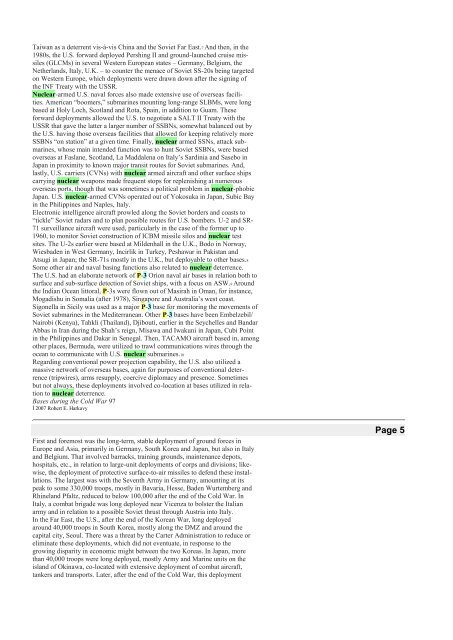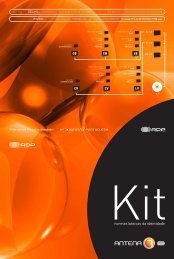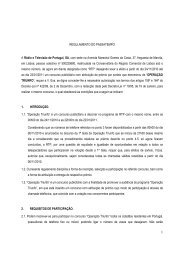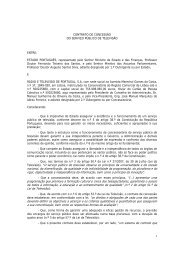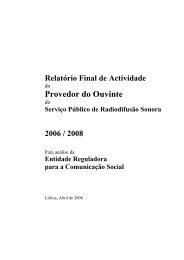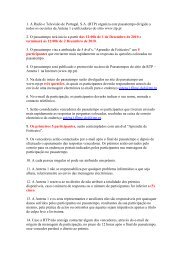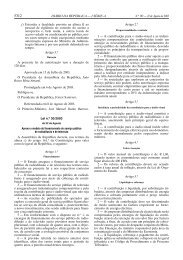This provided <strong>the</strong> U.S. access to a plethora of air and naval bases: Gibraltar,Malta, Cyprus, <strong>the</strong> Suez Canal Zone, Aden, Libya (Wheelus Air Force Base),Gan in <strong>the</strong> Maldives Islands, Mombasa, Simonstown in South Africa, Freetown,Singapore, Hong Kong, etc., added to by access to o<strong>the</strong>r facilities in Canada andAustralia. France’s remnant empire allowed for some U.S. access as well,particularly important in <strong>the</strong> 1950s, regarding bomber bases and communicationsfacilities in Morocco. During <strong>the</strong> period after 1945, of course, <strong>the</strong> U.S.occupied Germany and Japan, and had free access to bases all over occupiedEurope, in France, <strong>the</strong> Ne<strong>the</strong>rlands, Belgium, Italy, Greece and Turkey. In <strong>the</strong>Central Pacific, <strong>the</strong> U.S. took over <strong>the</strong> former Japanese League of Nations mandatesin <strong>the</strong> Caroline, Mariana and Marshall Islands, with few restrictions on<strong>the</strong>ir use for bases.In <strong>the</strong> early 1950s <strong>the</strong>re was <strong>the</strong> full onset of <strong>the</strong> <strong>Cold</strong> <strong>War</strong>, <strong>the</strong> Korean <strong>War</strong>,and NSC-68 as <strong>the</strong> formalization of <strong>the</strong> containment policy. Importantly, <strong>the</strong>rewas also <strong>the</strong> construction by <strong>the</strong> U.S. of a network of formal alliances, both<strong>Bases</strong> <strong>during</strong> <strong>the</strong> <strong>Cold</strong> <strong>War</strong> 95İ 2007 Robert E. Harkavymultilateral and bilateral, that formed a physical barrier around what had cometo be called <strong>the</strong> Sino-Soviet bloc after 1949, a barrier extending around Eurasiafrom Ireland and Norway around to Japan. There was NATO, CENTO (<strong>the</strong>Baghdad Pact) and SEATO, <strong>the</strong> first two hinged on Turkey, <strong>the</strong> latter two onPakistan, abetted by ANZUS and <strong>the</strong> bilateral defense pacts with Japan, SouthKorea (after 1950) and Taiwan (after 1950).3 Arms transfers and o<strong>the</strong>r forms ofsecurity and economic assistance underpinned all of <strong>the</strong>se alliances, and with<strong>the</strong>m went a very permissive and comprehensive basing structure for <strong>the</strong> U.S., ineffect in exchange for security against <strong>the</strong> perceived menace of Soviet andChinese expansionism, both in terms of possible military attack and internal subversion.The physical structure of this basing network was neatly reflective of arimland defense posture around Eurasia à la <strong>the</strong> geopolitical formulations ofMahan and Spykman.Functions of <strong>the</strong> U.S. <strong>Cold</strong> <strong>War</strong> basing systemAs <strong>the</strong> <strong>Cold</strong> <strong>War</strong> evolved in <strong>the</strong> 1950s and 1960s, <strong>the</strong> functions of <strong>the</strong> U.S.global basing structure came to be divided along <strong>the</strong> lines of nuclear deterrenceand conventional deterrence and power projection. The latter category fur<strong>the</strong>rsubsumed <strong>the</strong> use of bases for direct military interventions, arms resupply <strong>during</strong>conflict, coercive diplomacy (“gunboat diplomacy”) and “presence” (showing<strong>the</strong> flag).4The initial use of forward bases came with <strong>the</strong> stationing of B-29 bombers in<strong>the</strong> U.K. in <strong>the</strong> late 1940s. Following that was <strong>the</strong> stationing, in <strong>the</strong> 1950s, of B-47 “Reflex Force” bombers in <strong>the</strong> U.K., Spain and Morocco.5 Shortly after that,<strong>the</strong> B-52 bombers were introduced as <strong>the</strong> backbone of SAC, and <strong>the</strong>y were allbased along <strong>the</strong> nor<strong>the</strong>rn rim of <strong>the</strong> continental U.S., in Maine, New Hampshire,upstate New York and Michigan. But, <strong>the</strong>y required tanker refueling, bases forwhich were established in Greenland (Thule), Canada (Gander), Iceland(Keflavik) and in <strong>the</strong> U.K. Additionally, numerous bases in Europe and elsewherewere designated as recovery bases for <strong>the</strong> bombers should <strong>the</strong>y exit <strong>the</strong>USSR after a bombing raid.Later in <strong>the</strong> Gulf <strong>War</strong>, forward based tactical aircraft (FBS) – F-4s, F-16s,and F-15s – were configured for nuclear weapons, based mostly in Germany, butable to mount missions from o<strong>the</strong>r bases in Europe, in Iceland, <strong>the</strong> Ne<strong>the</strong>rlands,Italy and Turkey.6 Additionally, F-111E bombers based in <strong>the</strong> U.K. weredeployed as nuclear attack aircraft that could reach into <strong>the</strong> Soviet Union.Nuclear armed attack aircraft were also based in South Korea and <strong>the</strong> Philippines,capable of reaching <strong>the</strong> USSR and China. Tanker aircraft based on Guam,Okinawa, Japan and <strong>the</strong> Philippines could also serve in relation to nuclear-armedaircraft.In <strong>the</strong> late 1950s, in response to <strong>the</strong> “missile scare,” i.e., <strong>the</strong> looming threat ofSoviet ICBM deployments ahead of similar U.S. deployments, <strong>the</strong> U.S. basedmedium-range ballistic missiles, Thor and Jupiter, in <strong>the</strong> U.K., Italy and Turkey.In Asia, Matador and Mace land-based missiles were deployed in Okinawa and96 <strong>Bases</strong> <strong>during</strong> <strong>the</strong> <strong>Cold</strong> <strong>War</strong>İ 2007 Robert E. HarkavyPage 3Page 4
Taiwan as a deterrent vis-à-vis China and <strong>the</strong> Soviet Far East.7 And <strong>the</strong>n, in <strong>the</strong>1980s, <strong>the</strong> U.S. forward deployed Pershing II and ground-launched cruise missiles(GLCMs) in several Western European states – Germany, Belgium, <strong>the</strong>Ne<strong>the</strong>rlands, Italy, U.K. – to counter <strong>the</strong> menace of Soviet SS-20s being targetedon Western Europe, which deployments were drawn down after <strong>the</strong> signing of<strong>the</strong> INF Treaty with <strong>the</strong> USSR.Nuclear-armed U.S. naval forces also made extensive use of overseas facilities.American “boomers,” submarines mounting long-range SLBMs, were longbased at Holy Loch, Scotland and Rota, Spain, in addition to Guam. Theseforward deployments allowed <strong>the</strong> U.S. to negotiate a SALT II Treaty with <strong>the</strong>USSR that gave <strong>the</strong> latter a larger number of SSBNs, somewhat balanced out by<strong>the</strong> U.S. having those overseas facilities that allowed for keeping relatively moreSSBNs “on station” at a given time. Finally, nuclear armed SSNs, attack submarines,whose main intended function was to hunt Soviet SSBNs, were basedoverseas at Faslane, Scotland, La Maddalena on Italy’s Sardinia and Sasebo inJapan in proximity to known major transit routes for Soviet submarines. And,lastly, U.S. carriers (CVNs) with nuclear armed aircraft and o<strong>the</strong>r surface shipscarrying nuclear weapons made frequent stops for replenishing at numerousoverseas ports, though that was sometimes a political problem in nuclear-phobicJapan. U.S. nuclear-armed CVNs operated out of Yokosuka in Japan, Subic Bayin <strong>the</strong> Philippines and Naples, Italy.Electronic intelligence aircraft prowled along <strong>the</strong> Soviet borders and coasts to“tickle” Soviet radars and to plan possible routes for U.S. bombers. U-2 and SR-71 surveillance aircraft were used, particularly in <strong>the</strong> case of <strong>the</strong> former up to1960, to monitor Soviet construction of ICBM missile silos and nuclear testsites. The U-2s earlier were based at Mildenhall in <strong>the</strong> U.K., Bodo in Norway,Wiesbaden in West Germany, Incirlik in Turkey, Peshawar in Pakistan andAtsugi in Japan; <strong>the</strong> SR-71s mostly in <strong>the</strong> U.K., but deployable to o<strong>the</strong>r bases.8Some o<strong>the</strong>r air and naval basing functions also related to nuclear deterrence.The U.S. had an elaborate network of P-3 Orion naval air bases in relation both tosurface and sub-surface detection of Soviet ships, with a focus on ASW.9 Around<strong>the</strong> Indian Ocean littoral, P-3s were flown out of Masirah in Oman, for instance,Mogadishu in Somalia (after 1978), Singapore and Australia’s west coast.Sigonella in Sicily was used as a major P-3 base for monitoring <strong>the</strong> movements ofSoviet submarines in <strong>the</strong> Mediterranean. O<strong>the</strong>r P-3 bases have been Embelzebil/Nairobi (Kenya), Tahkli (Thailand), Djibouti, earlier in <strong>the</strong> Seychelles and BandarAbbas in Iran <strong>during</strong> <strong>the</strong> Shah’s reign, Misawa and Iwakuni in Japan, Cubi Pointin <strong>the</strong> Philippines and Dakar in Senegal. Then, TACAMO aircraft based in, amongo<strong>the</strong>r places, Bermuda, were utilized to trawl communications wires through <strong>the</strong>ocean to communicate with U.S. nuclear submarines.10Regarding conventional power projection capability, <strong>the</strong> U.S. also utilized amassive network of overseas bases, again for purposes of conventional deterrence(tripwires), arms resupply, coercive diplomacy and presence. Sometimesbut not always, <strong>the</strong>se deployments involved co-location at bases utilized in relationto nuclear deterrence.<strong>Bases</strong> <strong>during</strong> <strong>the</strong> <strong>Cold</strong> <strong>War</strong> 97İ 2007 Robert E. HarkavyFirst and foremost was <strong>the</strong> long-term, stable deployment of ground forces inEurope and Asia, primarily in Germany, South Korea and Japan, but also in Italyand Belgium. That involved barracks, training grounds, maintenance depots,hospitals, etc., in relation to large-unit deployments of corps and divisions; likewise,<strong>the</strong> deployment of protective surface-to-air missiles to defend <strong>the</strong>se installations.The largest was with <strong>the</strong> Seventh Army in Germany, amounting at itspeak to some 330,000 troops, mostly in Bavaria, Hesse, Baden Wurtemberg andRhineland Pfaltz, reduced to below 100,000 after <strong>the</strong> end of <strong>the</strong> <strong>Cold</strong> <strong>War</strong>. InItaly, a combat brigade was long deployed near Vicenza to bolster <strong>the</strong> Italianarmy and in relation to a possible Soviet thrust through Austria into Italy.In <strong>the</strong> Far East, <strong>the</strong> U.S., after <strong>the</strong> end of <strong>the</strong> Korean <strong>War</strong>, long deployedaround 40,000 troops in South Korea, mostly along <strong>the</strong> DMZ and around <strong>the</strong>capital city, Seoul. There was a threat by <strong>the</strong> Carter Administration to reduce oreliminate <strong>the</strong>se deployments, which did not eventuate, in response to <strong>the</strong>growing disparity in economic might between <strong>the</strong> two Koreas. In Japan, morethan 40,000 troops were long deployed, mostly Army and Marine units on <strong>the</strong>island of Okinawa, co-located with extensive deployment of combat aircraft,tankers and transports. Later, after <strong>the</strong> end of <strong>the</strong> <strong>Cold</strong> <strong>War</strong>, this deploymentPage 5
- Page 4 and 5: ecame a hot issue within Japan, and
- Page 6 and 7: SpainRotaMajor naval base; also air
- Page 8 and 9: eturn to the link here with aircraf
- Page 10 and 11: which were in Fairbanks (Alaska), T
- Page 13: Molesworth), Belgium (Florennes), t
- Page 17 and 18: III,” 14 stations giving flexible
- Page 19 and 20: wire retaliation strike plan. The n
- Page 21 and 22: Ocean surface surveillance47The U.S
- Page 23 and 24: each site, providing variable cover
- Page 25 and 26: Pinetree LineCanadaBroughton Island
- Page 27 and 28: that is, the Limited Test Ban Treat
- Page 29 and 30: Missile Crisis.68At another level,
- Page 31 and 32: Access for Soviet surface ships.Per
- Page 33 and 34: nel in Libya, whose air force compr
- Page 35 and 36: systems (an exception, of course wa
- Page 37 and 38: Madagascar). There was also a signi
- Page 39 and 40: Aden, Bahrain, Malta, Mauritius, Si


